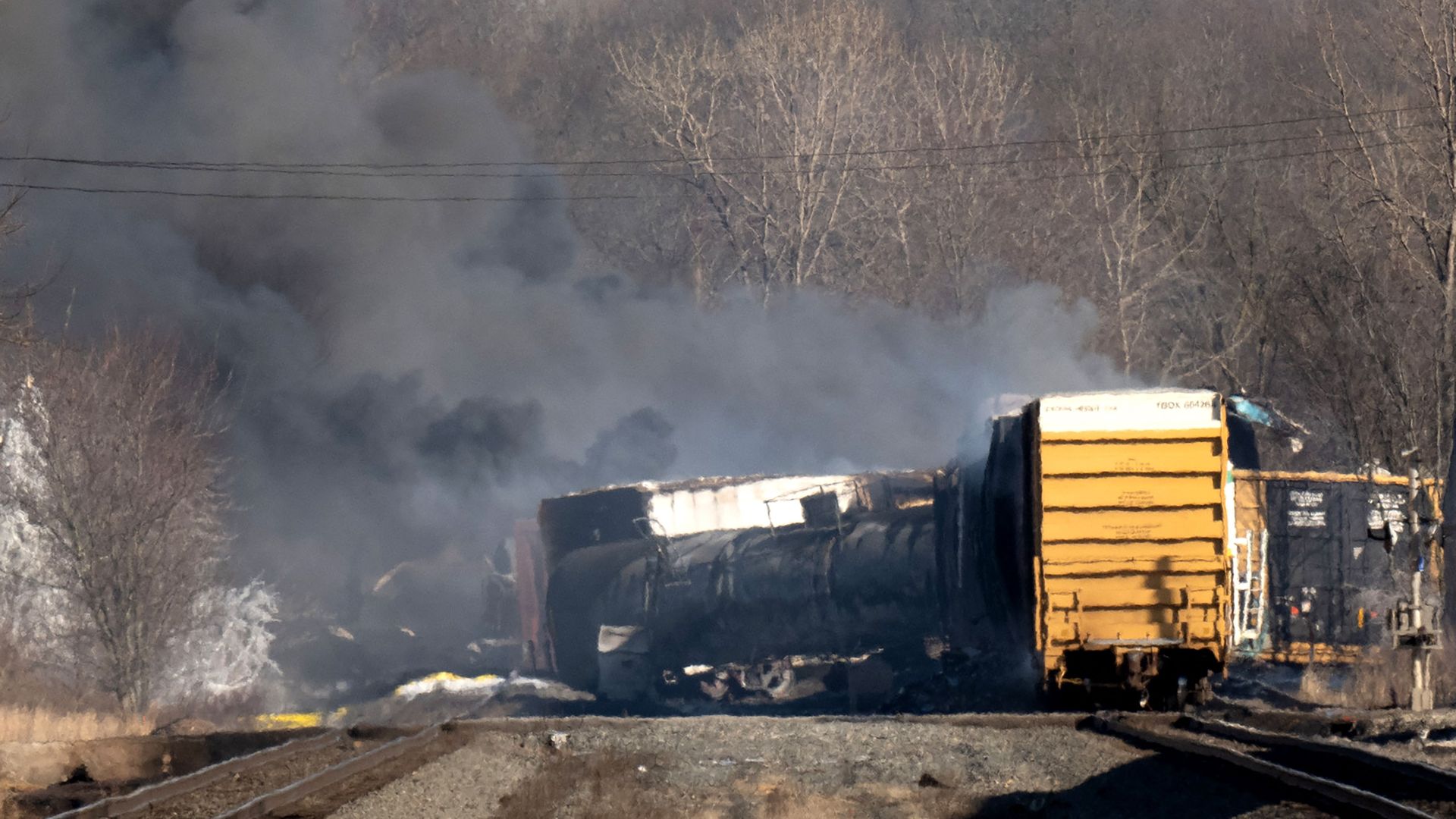Toxic Chemicals From Ohio Train Derailment: Lingering Contamination In Buildings

Table of Contents
Pathways of Chemical Contamination into Buildings
The release of hazardous substances during the Ohio train derailment created multiple pathways for contamination to reach and infiltrate buildings in the surrounding area. Understanding these pathways is crucial for effective mitigation and remediation efforts.
Airborne Contamination
Volatile organic compounds (VOCs), such as butyl acrylate and ethylhexyl acrylate, released during the derailment, readily entered the atmosphere. These VOCs, depending on wind direction and atmospheric conditions, could have traveled considerable distances, penetrating buildings through various routes.
- Specific VOCs: The specific mix of VOCs released influences the extent and nature of the contamination. Butyl acrylate and ethylhexyl acrylate are known irritants and can cause respiratory problems.
- Wind Direction and Dispersion: Prevailing wind patterns played a significant role in the distribution of airborne contaminants, potentially concentrating contamination in specific areas.
- Long-Range Transport: Studies have shown that some VOCs can remain airborne for extended periods, facilitating long-range transport of contaminants, affecting buildings far from the immediate derailment site. Further research into the persistence of these specific chemicals is needed to fully understand their long-term impact.
Surface Contamination
Less volatile chemicals, along with particulate matter carrying residual contaminants, settled on surfaces—soil, vegetation, and even dust. This surface contamination could then be inadvertently transported into buildings.
- Examples of Less Volatile Compounds: Certain chemicals released during the derailment are less volatile and may have adhered to surfaces for extended periods.
- Persistence on Surfaces: These chemicals can persist on surfaces like dust and soil, creating a secondary source of contamination.
- Secondary Contamination: People's shoes, clothing, and even animals could have easily carried these contaminated particles into homes and other structures. Contaminated soil near building foundations can leach these chemicals into basements over time.
Water Contamination
Groundwater and surface water sources near the derailment site could have been contaminated, posing a threat to building plumbing systems and potentially leading to waterborne illness.
- Chemical Leaching: Rainwater runoff and groundwater infiltration can leach chemicals from contaminated soil into water sources.
- Drinking Water Contamination: Contaminated water poses serious health risks, particularly if used for drinking or cooking.
- Impact on Building Materials: Water contamination can also damage building materials, potentially leading to structural issues over time. Further investigation is needed to determine the long-term impact of this water contamination.
Health Impacts of Lingering Contamination
Exposure to the toxic chemicals released during the Ohio train derailment can cause a range of adverse health effects, both short-term and long-term.
Respiratory Issues
Inhalation of VOCs and other airborne contaminants can trigger a variety of respiratory problems.
- Specific Respiratory Illnesses: Exposure can cause asthma exacerbations, bronchitis, and other respiratory illnesses.
- Symptoms to Watch For: Individuals should monitor for symptoms such as coughing, wheezing, shortness of breath, and chest tightness.
- Vulnerable Populations: Children, the elderly, and individuals with pre-existing respiratory conditions are particularly vulnerable.
Neurological Effects
Some of the chemicals released during the derailment have been linked to neurological effects.
- Specific Neurological Symptoms: Symptoms can range from headaches and dizziness to more severe neurological conditions.
- Long-Term Consequences: Long-term exposure can lead to cognitive impairment and other debilitating neurological disorders.
- Challenges in Diagnosis: The connection between chemical exposure and neurological symptoms can be difficult to establish, requiring specialized medical expertise.
Other Health Concerns
Long-term exposure to the released chemicals may also present other health risks.
- Skin Irritations: Direct contact with contaminated surfaces can cause skin rashes, irritation, and other dermatological problems.
- Cancer Risks: Certain chemicals released during the derailment are known carcinogens, increasing the risk of various cancers.
- Reproductive Problems: Some chemicals may impact reproductive health, potentially causing infertility or birth defects. Further research into long-term reproductive health effects is warranted.
Mitigation and Remediation Strategies
Addressing the lingering contamination from the Ohio train derailment requires a multi-pronged approach involving air, surface, and water remediation strategies.
Air Quality Testing and Improvement
Thorough air quality testing is essential to assess the extent of airborne contamination in affected buildings.
- Types of Testing: Various methods exist for detecting and quantifying VOCs and other airborne contaminants.
- Remediation Strategies: Improving ventilation systems, installing high-efficiency particulate air (HEPA) filters, and using air purifiers can help reduce indoor air pollution.
- Cost Considerations: The cost of air quality testing and remediation can vary significantly depending on the extent of contamination and the size of the building.
Surface Cleaning and Decontamination
Contaminated surfaces within buildings require professional cleaning and decontamination.
- Professional Cleaning Services: Specialized cleaning services experienced in hazardous material cleanup are necessary.
- Appropriate Cleaning Agents: The choice of cleaning agents depends on the specific contaminants present.
- Disposal of Contaminated Materials: Proper disposal of contaminated materials is crucial to prevent further spread of contamination.
Water Testing and Treatment
Testing for water contamination and implementing appropriate treatment measures are critical.
- Water Testing Protocols: Comprehensive water testing should be conducted to identify any contaminants present.
- Water Filter Installation: Installing high-quality water filters can remove many contaminants from drinking water.
- Water Purification Methods: In cases of severe contamination, more advanced water purification methods might be necessary.
Conclusion
The lingering contamination from the Ohio train derailment poses significant long-term health risks due to various pathways of chemical spread into buildings. The potential health impacts, ranging from respiratory problems to neurological effects and cancer risks, necessitate immediate action. Effective mitigation strategies, including air quality testing, surface decontamination, and water treatment, are crucial to protect residents. Don't ignore the lingering threat of toxic chemicals from the Ohio train derailment. Take steps today to ensure the safety of your home and family by getting your building tested for contamination and implementing appropriate remediation strategies. Contact local authorities and environmental health professionals for guidance and assistance in addressing the building contamination after the Ohio derailment. Protecting your health and the health of your family is paramount.

Featured Posts
-
 Strategies For Success How To Navigate Meetings With Trump
May 06, 2025
Strategies For Success How To Navigate Meetings With Trump
May 06, 2025 -
 Is Reggie Miller Nbcs New Lead Nba Analyst The Latest News
May 06, 2025
Is Reggie Miller Nbcs New Lead Nba Analyst The Latest News
May 06, 2025 -
 Hawaiis Kilauea Unusual Eruption Pattern Emerges After 38 Years Of Dormancy
May 06, 2025
Hawaiis Kilauea Unusual Eruption Pattern Emerges After 38 Years Of Dormancy
May 06, 2025 -
 Westpac Wbc Shrinking Margins Lead To Lower Profitability
May 06, 2025
Westpac Wbc Shrinking Margins Lead To Lower Profitability
May 06, 2025 -
 Patrick Schwarzenegger Cruises La In His Vintage Bronco
May 06, 2025
Patrick Schwarzenegger Cruises La In His Vintage Bronco
May 06, 2025
Latest Posts
-
 2025 Met Gala Livestream Accessing The Event From Latin America Mexico And The U S
May 06, 2025
2025 Met Gala Livestream Accessing The Event From Latin America Mexico And The U S
May 06, 2025 -
 Livestreaming The 2025 Met Gala A Guide For Viewers In Latin America Mexico And The U S
May 06, 2025
Livestreaming The 2025 Met Gala A Guide For Viewers In Latin America Mexico And The U S
May 06, 2025 -
 The Unexpected Trio Jeff Goldblum Ariana Grande And The Mildred Snitzer Orchestras I Dont Know Why I Just Do
May 06, 2025
The Unexpected Trio Jeff Goldblum Ariana Grande And The Mildred Snitzer Orchestras I Dont Know Why I Just Do
May 06, 2025 -
 Jeff Goldblum Ariana Grande Collaboration I Dont Know Why I Just Do A Deep Dive
May 06, 2025
Jeff Goldblum Ariana Grande Collaboration I Dont Know Why I Just Do A Deep Dive
May 06, 2025 -
 I Dont Know Why I Just Do Jeff Goldblum Ariana Grande And The Mildred Snitzer Orchestras Unexpected Hit
May 06, 2025
I Dont Know Why I Just Do Jeff Goldblum Ariana Grande And The Mildred Snitzer Orchestras Unexpected Hit
May 06, 2025
